When you live alone in Japan, you will have fixed monthly expenses such as rent and management fees, but among them, your water bill will vary greatly depending on how you use it. Since water is involved in everything from cooking to bathing to cleaning, if you don’t have the knowledge, you may end up with a high-water bill even though you live alone. In this section, I will write about the average water bill, places where you tend to use a lot of water, and how to save money on your water bill. For more information about saving money on electricity and gas, please see the following article.
Average water bill for a single person living in Japan
Let’s start by looking at the average monthly water bill of a working household, with only one individual, based on data from the Ministry of Internal Affairs and Communications’ 2019 Household Budget Survey: 1,908 yen in 2017, 1,973 yen in 2018, and 1,921 yen in 2019.
The average water bill in recent years has been around 1,900 yen and the data for 2019 show that the average annual water bill is 23,052 yen. Note that in many areas, water bills are charged every two months, so if you live alone, almost 4,000 yen per bill is expected. However, water rates can vary depending on the region, season, and lifestyle. In particular, lifestyle and time spent at home have a large impact on water and utility bills, so a lot of people may find that their water and utility bills have become higher in recent years due to the spread of teleworking and telecommuting. Moreover, it seems that water bills vary depending on where you live. Although I don’t live alone, a survey found a difference of a little over 6,000 yen in 47 prefectures across Japan.
Whether approximately 2,000 yen per month is high or low depends on the person, but since it is an average amount with no savings, it can be said that it is possible to make it even cheaper with ingenuity.
How to Calculate Water Charges
The water bill is determined by the following formula: water bill + sewerage bill. The water usage fee is for the drinkable water that comes out of the kitchen faucet, while the sewerage fee is for discharging domestic wastewater into the sewage system. Water and sewerage charges are calculated as “basic charge + metered charge”. The metered charge is set according to the nominal diameter of the water supply pipe, which ranges from 13mm to 25mm for general household water supply. Therefore, water rates vary depending on the nominal diameter of your home. The basic water bill also varies depending on the distance from the water source, the quality of the water, and the timing of the installation of the water supply, so it also depends on the water bureau in your area. Moreover, the basic fee includes a usage fee up to a certain level. As long as you do not use a large amount of water, the usage fee will not be added, so the fee will be the same throughout the year.
Things that use the most water in our daily lives
Most apartments in Japan have a bathtub. After all, if you live in Japan, you want to take a bath in a bathtub. Such bathtubs use a lot of water in our daily lives. A typical bathtub uses about 14 to 18 liters of water, so if you take a bath every day using the bathtub, you will use quite a lot of water. Some people may think, “I take showers most of the time, so I’m fine.” However, the truth is that taking a shower for 10 minutes and filling the bathtub with water is almost the same. In other words, even if you only take showers and not baths, you are consuming the same amount of water as if you were taking a bath every day. If you take a shower twice a day, morning and evening, your water bill will be the same as if you took a bath twice a day. To lower your water bill, you need to reduce the use of water when you bathe.
How to save money
To save money on your water bill, it is easy to see the effects if you start with the areas that you use most often. When you feel the effect, you will be motivated to save money, and you will be able to focus on saving money in other areas. The key to saving money is not to limit yourself temporarily, but to continue it over time. The first step is to learn how to save money in a way that it’ll be sustainable and easy to follow.
Bath
The bath, which uses the most water, has many ways to save money. However, since bath time is also a time for relaxation, it is recommended to practice stress-free ways to save money.
1. Don’t fill the bathtub with water, just use the shower
The easiest way to save money is to not fill the bathtub with hot water and just use the shower. I mentioned above that the amount of water used for both showering and bathing is the same, but that is only if you use the shower for 10 minutes. In other words, if you take a shower in 5 minutes, you can save more money than if you take a bath, so you can save money by taking shorter showers.
2. Don’t leave the shower running
This may be a little hard to do in winter, but in warmer seasons such as spring and summer, you can save money by not leaving the shower running. If you make a habit of turning off the shower frequently, you can reduce the amount of water used even if you use it for 10 minutes.
3. Replace your traditional shower head with a water-saving one.
If you prefer to leave the shower running all the time, replace the showerhead with a water-saving type. These days, some high-spec water-saving showerheads do not reduce water pressure or water volume, so it is a good idea to check the reviews and choose one that is highly rated and as well as highly recommended.
Toilets
Next, let’s take a look at how to save money on toilets. There are a variety of ways to save money on toilets, so let’s start with the ones that are the least burdensome.
1. Toilet levers of different sizes
Toilets don’t have that much of an impact on your water bill, but if you want to save as much as possible, it’s important to use the right lever size. If you always use the “large” lever, the amount of water that goes down the drain will increase, so using the right size will help you save money.
2: Use a water-saving device called “Loss Cut”
The water-saving device “Loss Cut” is attached directly to the drain valve, so it does not reduce the water pressure, but ensures savings only in the amount of drainage. The water flowing from the tank to the toilet bowl is designed to swirl in order to clean the entire bowl evenly. This swirl also occurs inside the toilet tank. This is because otherwise, the water would not be able to spread quickly and evenly throughout the toilet bowl. However, the whirlpool in the tank can cause the faucet to get caught in the whirlpool and drift around, making it impossible to turn on the faucet for any length of time.
Therefore, it is necessary to turn on the faucet as soon as possible after cleaning the toilet bowl. Inside the toilet tank, there is a part called a rubber float that floats when water is flushed, and when the flushing is finished, it acts as a lid to stop the water. By attaching the water-saving unit “Roskat” to the rubber float, the timing of the lid closing can be accelerated. In the beginning, the water flows vigorously, but at the end, the water stops flowing and stays in the tank to save water. No maintenance is required and the effect is semi-permanent.
Laundry
For laundry, your water bill will vary depending on how you use your washing machine. If you practice money-saving techniques, it is easy to be reflected in your water bill, albeit a little.
1. Wash your laundry in bulk as much as possible.
It depends on the season, but if you live alone, there may be days when you don’t have that much laundry to do. Many people think that if they don’t have a lot of laundries to do, they can just do it with less water. However, the less laundry you do, the more money you save, so try to do as much laundry as possible in one load.
2. Use leftover bath water to do laundry
When you take a bath, use the leftover water from the bath to do your laundry. These days, many clothes washers are equipped with a mode to wash clothes with leftover water.
There are also washing machines that can automatically suck up bath water and wash your clothes with it, so it is a good idea to choose one that has this function when you are out looking for a new washing machine.
Kitchen
Next to the bathroom, water used in the kitchen is the second most cost-effective activity in terms of water bills. From the fact that it is called a “water area,” the kitchen uses a lot of water for both cooking and washing. If you’re not careful, your water bill can skyrocket, so it’s important to practice good conservation techniques.
1. Don’t leave the water running when washing dishes.
One of the most wasteful ways to use water in the kitchen is to leave the water running when washing dishes. If you want to do something else while washing dishes, make sure to turn off the water.
2. Wash dishes in small batches after they have accumulated to a certain extent.
It may be unpleasant to have dirty dishes in the sink, but it is best to wash a small number of dishes at a time after they have accumulated. Even dirty dishes don’t look so bad if they are properly arranged and soaked in the sink. If you wash the dishes for breakfast and lunch, you won’t have to worry about it so much.
3. When washing oily items, wipe off the dirt with kitchen paper before washing.
Washing pots and dishes with oil on them requires a lot of detergents, which means that a lot of water is used when rinsing. If there is an oil stain from frying or deep-frying, wipe off the oil lightly with kitchen paper before washing.
4. Washing in a dishwasher
If you have a dishwasher, you can save on water bills by washing in bulk. If you have a dishwasher, you can save on water bills by washing in bulk. However, if you wash only a small amount of food, you may end up wasting water. Washing dishes by hand can save a lot of water and energy.
5. Use the microwave to pre-cook vegetables.
If you boil vegetables in hot water, you will have to pay for both water and gas. If you use a microwave oven, you only need to pay for electricity, so instead of using the stove, using the microwave is more essential.






Comments